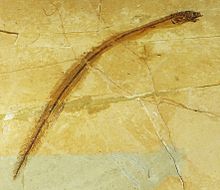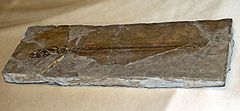Monte Bolca is a lagerstätte near Verona, Italy that was one of the first fossil sites with high quality preservation known to Europeans, and is still an important source of fossils from the Eocene.

The moonfish of the genus Mene, the sole extant genus of the family Menidae, are disk-shaped fish which bear a vague resemblance to gourami, thanks to their thread-like pelvic fins. Today, the genus is represented only by Mene maculata of the Indo-Pacific, where it is a popular food fish, especially in the Philippines, where it is known as bilong-bilong, chabita, hiwas or tahas.
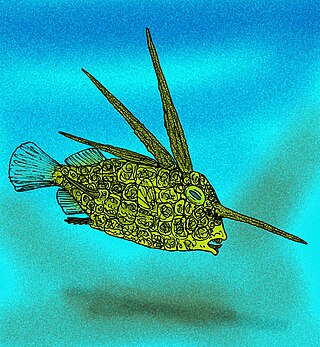
Eospinus daniltshenkoi is an extinct tetraodontid bony fish from the Eocene. Its fossils are from the Danata Formation lagerstatten of Ypresian Turkmenistan.

Ceratoichthys is an extinct genus of lookdown-like prehistoric jackfish that lived during the late Ypresian epoch, of the Early Eocene. It contains a single species, C. pinnatiformis of Monte Bolca, Italy. It and Vomeropsis are the only known members of the extinct subfamily Vomeropsinae.

Aeoliscoides is an extinct genus of prehistoric ray-finned fish that lived from the early Eocene. It is known from a single species, A. longirostris, from the famous Monte Bolca site of Italy. It was a member of Centriscidae, making it a relative of modern shrimpfish and snipefish. Its name references its close resemblance to the extant shrimpfish genus Aeoliscus.
Aulostomoides is an extinct genus of prehistoric marine ray-finned fish from the early Eocene. It contains a single species, A. tyleri from the Monte Bolca site of Italy. It is thought to be a member of Aulostomoidea, making it a relative of trumpetfish and cornetfish.
Calamostoma is an extinct relative of the ghost pipefish that lived during the early Eocene. It contains a single species, C. lesiniforme from the famous Monte Bolca site of Italy. It is one of the few known fossil ghost pipefishes. Calamostoma and the other Bolca solenostomid, Solenorhynchus, are both placed in the extinct subfamily Solenorhynchinae.
Aulorhamphus is an extinct genus of prehistoric marine ray-finned fish that lived from the early to middle Eocene. It contains four species known from the Early Eocene of Italy and the Middle Eocene of Russia. It was an aulorhamphid, an extinct family of syngnathiform fishes.
Anguilloides is an extinct genus of prehistoric marine eel that lived in the early Eocene. It contains a single species, A. branchiostegalis. Fossils are known from the famous Monte Bolca site of Italy.
Bolcanguilla is an extinct genus of prehistoric marine eel that lived during the early division of the Eocene epoch. It contains a single species, B. brachycephala from the Monte Bolca site of Italy. Its exact taxonomic affinities within the Anguilliformes remain uncertain.

Acanthonemus is an extinct genus of prehistoric marine ray-finned fish that lived from the early Eocene. It contains a single species, A. subaureus, known from the famous Monte Bolca site in Italy. It is the only genus in the extinct family Acanthonemidae.

Coelogaster is an extinct genus of marine ray-finned fish that lived during the early Eocene. It contains a single species, C. leptostea, known from the famous Monte Bolca site of Italy.
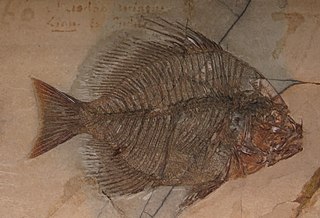
Archaephippus is an extinct genus of prehistoric spadefish that lived from the early Eocene. It contains a single species, A. asper, known from Italy. Several exquisitely preserved fossils have been found from the Monte Bolca lagerstatten. Some juvenile specimens preserve the vertical striped coloration that they would have likely had in life.
Callipteryx is an extinct genus of prehistoric marine trachiniform fish that lived during the early Eocene. It is the only known member of the extinct family Callipterygidae. It is thought to have been a relative of weeverfishes.
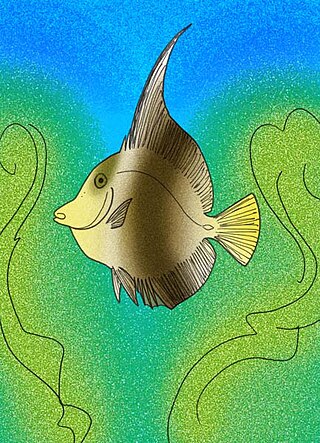
Eozanclus brevirostris is an extinct relative of the Moorish idol that lived during the late Ypresian epoch of the Eocene in what is now Monte Bolca, northern Italy. It differs from its living relative by having a much shorter snout.
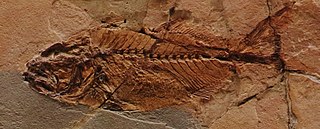
Carangopsis is an extinct relative of the bluefish that lived during the early Eocene. It contains two species, both from the famous Monte Bolca site of Italy.

Carangodes is an extinct genus of prehistoric ray-finned fish that lived during the early Eocene. It contains a single species, C. bicornis, from the famous Monte Bolca site in Italy. It is the only known member of the extinct perciform family Carangodidae.
Acanthopygaeus is an extinct genus of prehistoric marine perciform fish in the family Siganidae. It is known from the Eocene lagerstätte "Pesciara" in Bolca, Italy.

Dalpiazella is an extinct genus of prehistoric marine eel from the Eocene of Europe. It contains a single species, D. brevicauda, from the late Ypresian-aged Monte Bolca lagerstatten of Italy. It is though to be closely related to the sympatric genus Paranguilla, with both genera together constituting the family Paranguillidae.

Cyclopoma is an extinct genus of marine perciform fish from the Eocene. It is known from the Ypresian to the Lutetian of Europe and eastern North America.
